Cities / Healthy Cities
Integrating health and wellness with ecology and economy: healthy landscape, healthy communities
By Andrew Tindsley | 31 Jan 2018 | 0
This paper describes a number of projects in the UK and New Zealand, where the involvement of communities is helping shape healthier city landscapes and public realm spaces that encourage activity and mobility.
As a species, human beings are not as fit as we should be; more importantly, we’re not as fit as we could be. This is a problem that has become worse during my own lifetime, with statistics showing that we’re 20 per cent less physically active than we were in the 1960s and now walk 15 fewer miles each year than we did just 20 years ago.
While the figures may not be startling they have dramatic consequences. We’re told that just ten minutes of brisk walking each day can improve our health by 15 per cent. Sadly, a huge proportion of the British population, around six million people, doesn’t achieve this and, more worryingly, fails to manage even ten minutes of walking each month. Another depressing statistic is that about a fifth of the UK’s middle-aged population can be defined as completely inactive. In stark terms, we’re told this level of inactivity accounts for around one in six of all deaths, at a cost to the NHS of almost £1 billion each year. Imagine if just part of that sum could be invested in the design of our external environment?
So, as a landscape architect and designer, what do I think we can do to help bring about change? Quite a lot in my view. Given BDP’s involvement in many aspects of the external environment, our projects show that we can work with health specialists and local communities to achieve simple, effective solutions that can ‘unleash’ the health and wellness potential of our outdoor space for the benefit of everyone who uses it. We must promote the good stories that are out there, and with passion and enthusiasm share this knowledge, and encourage others to embark on similar initiatives.
A zealous approach to the enhancement of the UK’s landscape environment has been taken before. Some 50 years ago, the country embarked on a programme of land reclamation stimulated by tragedies such as the Aberfan mining disaster. An extraordinary programme of land renewal led to extremely dangerous mountains of mined waste being dumped into attractive new landscapes. Some areas were transformed into woodland, others into pasture but, at the time, we didn’t fully realise the potential these new amenities could offer.
In varying ways, differing programmes of rural and urban land regeneration have continued, frequently creating attractive new environments. From being ‘nice to haves’, the benefits of our places and spaces are now being fully recognised, and we should continue to promote the opportunities and successes already achieved.Home and away
Unhealthy lifestyles are not an issue confined to the UK’s shores. In New Zealand, the problems are very similar. A large proportion of the population is overweight, with resulting health problems such as diabetes and heart disease being all too common. Similar to the UK, around one in three adults is obese and a further third overweight. Again, in the face of health issues of such serious proportions, attention is being directed at encouraging a broader cross-section of the population to be more active.
In Christchurch, for example, the community has come together to create the Healthy Christchurch Charter. Through this, the community agrees “to work together to promote, protect and improve the health and wellbeing of the people of Christchurch”. There are currently more than 200 signatories to the charter, including businesses, community groups, residents’ associations and government bodies.
The central idea is that all these sectors have a role to play in creating a healthier city, whether it be through recreation, employment, transport or environmental enhancement. The Christchurch Charter also makes reference to the earlier Ottawa Charter of 1986, a World Health Organisation initiative and part of its ‘Health for All’ policy.
Where are the opportunities?
There are solutions everywhere – simple streets, pocket parks, village greens or stretches of open countryside. With ‘joined-up’ thinking, imagination and persistence, it’s possible to make each location as inviting and attractive as possible and, in so doing, encourage individuals to walk and cycle rather than jump into a car.
While public funds continue to be limited, many creative, cost-effective solutions are being put in place and achieving fantastic results. The continuing goal must be to make our places and spaces more inviting, and ensure that using them becomes part of everyday life, rather than a special activity that we need to find time for in our already busy schedules.
Learning from others
Following the Christchurch earthquake in February 2011, BDP was given the opportunity to work with the city and its community on proposals to rejuvenate the corridor of the Avon River, where it passes through the heart of the city. 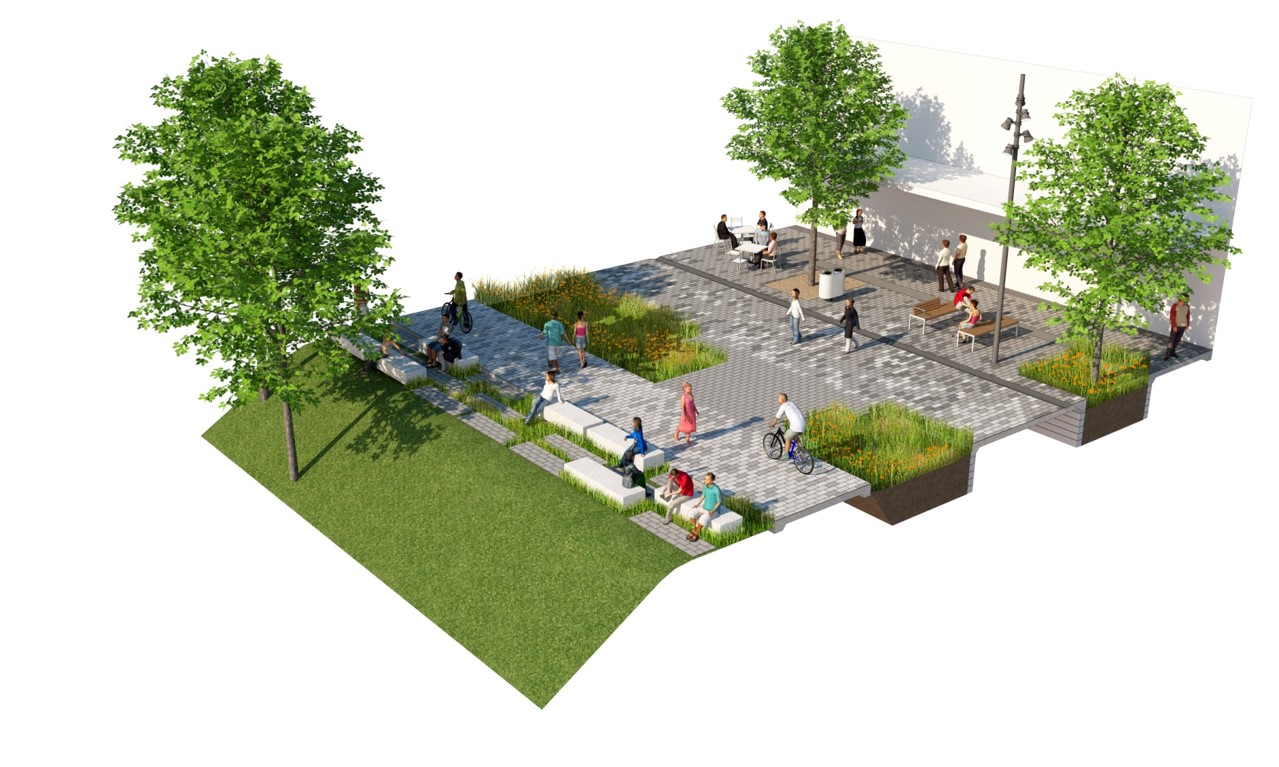
On one level, this project was about enhancement of a river corridor and replacing tremor-damaged pavements and dislocated bridge structures – but it was actually about far more. Working closely with the local Maori community, the project became about the creation of a ‘healthy river’, which in turn would create a ‘healthy city’ and help improve the wellbeing of everyone who lives and works in its environs. For the Maori community, a healthy river traditionally meant a better source of food, but in a contemporary context, a healthy river meant a watercourse that was free of pollutants washed in from adjacent highways and the re-establishment of a place that was inviting to use, as well as being home to indigenous amphibians, fish and birds.
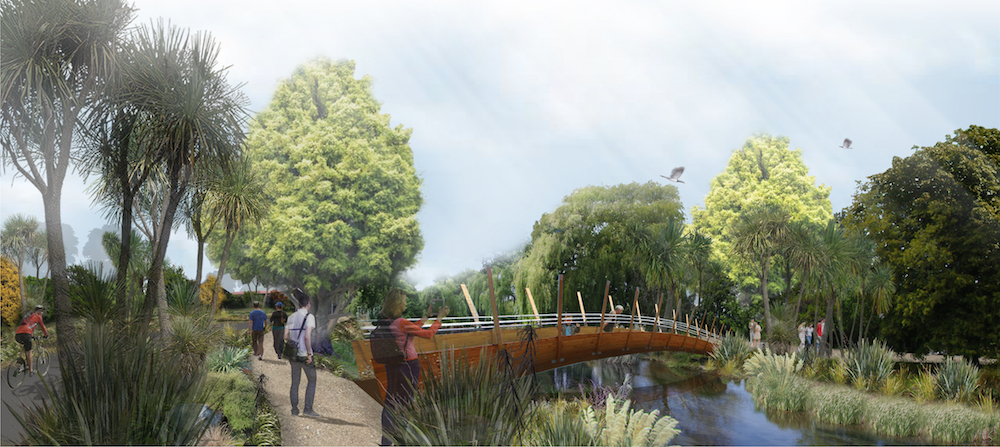
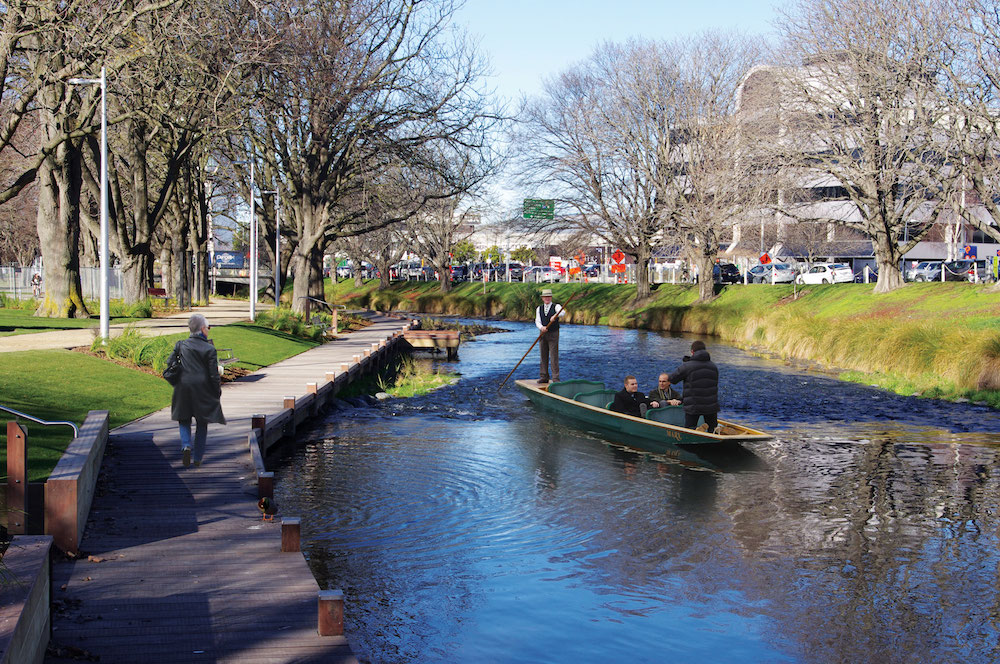 While Christchurch has a reputation as a ‘garden city’, its grid of highways and reliance on cars is closer to the North American model; so, in parallel with the river improvement works, the city developed proposals to encourage people out of their vehicles. The idea was to establish a network of footpaths and cycleways which wind their way along the river banks. In rebuilding the city, the opportunity to recreate a river corridor with less road space for vehicles and more attractive routes for walking and cycling became a fundamental design principle. The need for change is being embraced and, although the reconstruction of Christchurch still has some way to go, significant improvements are well under way.
While Christchurch has a reputation as a ‘garden city’, its grid of highways and reliance on cars is closer to the North American model; so, in parallel with the river improvement works, the city developed proposals to encourage people out of their vehicles. The idea was to establish a network of footpaths and cycleways which wind their way along the river banks. In rebuilding the city, the opportunity to recreate a river corridor with less road space for vehicles and more attractive routes for walking and cycling became a fundamental design principle. The need for change is being embraced and, although the reconstruction of Christchurch still has some way to go, significant improvements are well under way.
Places to meet and socialise also have a positive health benefit. Alongside the meandering footpaths and high-speed cycle commuting routes, the aspiration is to create a network of different places where people can come together and enjoy the company of others, or escape the pressure of city life and find a secluded space to enjoy a few quiet moments.
What we’re achieving at home
While it’s good to reflect on overseas initiatives, there are numerous excellent examples on the UK’s own doorstep. In Lewisham, south-east London, the borough council has invested heavily over the last decade in improving its open spaces and exploring ways in which they can be better connected. Improvements to the corridor of the River Ravensbourne, a tiny but important urban watercourse, provide an excellent example. Funded in part through the EU initiative QUERCUS (Quality Urban Environments for River Corridor Users and Stakeholders), the riverside space has been redesigned to provide its local communities with direct access to water and nature. 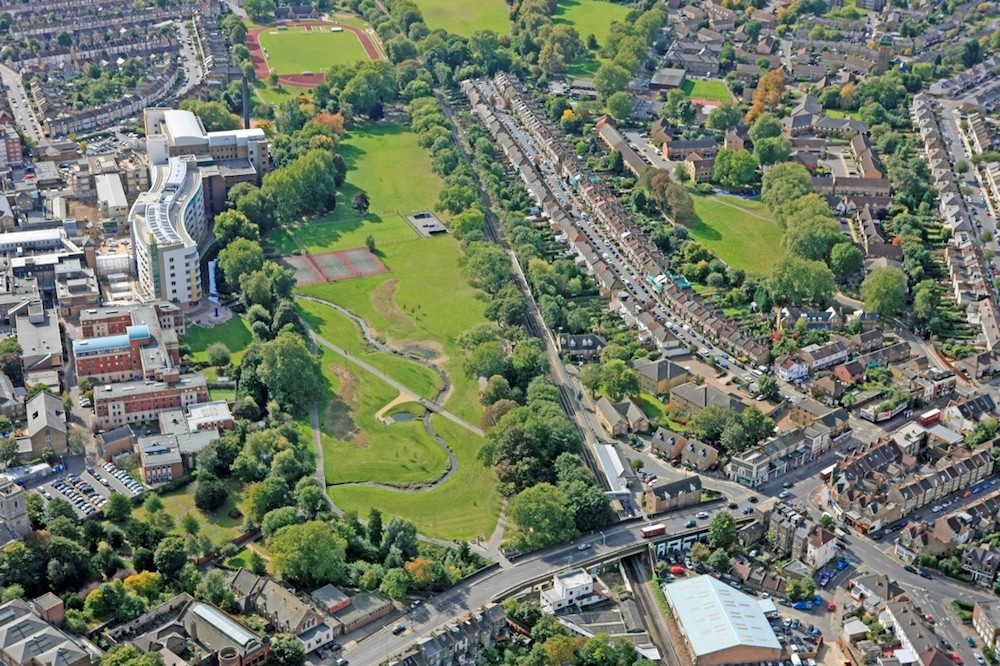
The walkways and open spaces present opportunities for people to exercise or go for a stroll, but they also provide places where they can meet their neighbours or just enjoy a quiet moment surrounded by greenery and birdsong. Ladywell Fields now has a well-used walking and cycling route, and is popular with joggers and dog walkers. Its three fields offer plenty of places to exercise, with children’s play parks, tennis courts, a fitness trail and a two-kilometre running loop. The ‘Walk 4 Life’ initiative includes Ladywell Fields as one of its 112,089 walking routes and Waterlink Way, a component of Lewisham’s walking network connecting Sydenham with the River Thames, also passes through the space.
Perhaps the most dramatic transformation of the River Ravensbourne corridor can be seen at Cornmill Gardens. There, a concrete channel was removed, enabling the river banks to be regraded and the water to flow more naturally. The gently sloping banks planted with indigenous vegetation have allowed new habitats to flourish and enabled the local community to get close to the water and wildlife it now supports. As with Ladywell Fields, Waterlink Way runs through the park.

 Lewisham is also home to Margaret McMillan Park, another highly successful urban space helping to bring the local community together. While the renewed space is encouraging greater use, perhaps the real point of interest is the person after whom the park is named. Margaret McMillan was a well-known Victorian Christian Socialist who recognised the benefits of outdoor play for poor children working in the harsh conditions of industrial Britain. This rejuvenated park project was all about trying to establish a health and wellbeing agenda and, in a modest way, we hope it reflects some of her vision. In addition to its play features, the park now has an inviting linear footway connecting New Cross Station with Deptford High Street. This is well used and, again, is part of a strategic network forming Route 1 of ‘North Lewisham Links’.
Lewisham is also home to Margaret McMillan Park, another highly successful urban space helping to bring the local community together. While the renewed space is encouraging greater use, perhaps the real point of interest is the person after whom the park is named. Margaret McMillan was a well-known Victorian Christian Socialist who recognised the benefits of outdoor play for poor children working in the harsh conditions of industrial Britain. This rejuvenated park project was all about trying to establish a health and wellbeing agenda and, in a modest way, we hope it reflects some of her vision. In addition to its play features, the park now has an inviting linear footway connecting New Cross Station with Deptford High Street. This is well used and, again, is part of a strategic network forming Route 1 of ‘North Lewisham Links’.
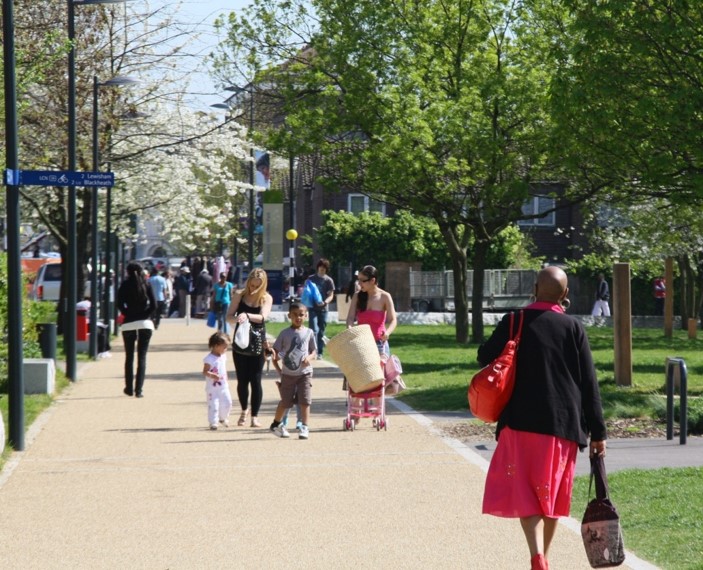 The London Borough of Lewisham continues to be ambitious; at Mountsfield Park, a local open space has been successfully remodelled to create a community garden and play area. Here, the local community has been involved with its design, construction and aftercare. It’s another compelling example of how a relatively small budget can be used to make a major contribution to the health and wellbeing of a local community.
The London Borough of Lewisham continues to be ambitious; at Mountsfield Park, a local open space has been successfully remodelled to create a community garden and play area. Here, the local community has been involved with its design, construction and aftercare. It’s another compelling example of how a relatively small budget can be used to make a major contribution to the health and wellbeing of a local community.
Public engagement was a cornerstone of the project. The local ‘Friends of the Park’ group was enthusiastic and contributed ideas and energy. Our design team spent many evenings with them in the park, sitting around a plan exploring just what could be created. Their involvement continued through to construction of the park, with the ‘Big Dig’ event being an excellent example of how locals can come together to assist with the work and, in doing so, get to know each other better and build a stronger community. The park now has its own pizza oven, and communal cooking is proving to be a good way to encourage interest and engagement. The challenge was to create an amazing facility on a limited budget, while the play space had to cater for a range of needs in one large play environment.
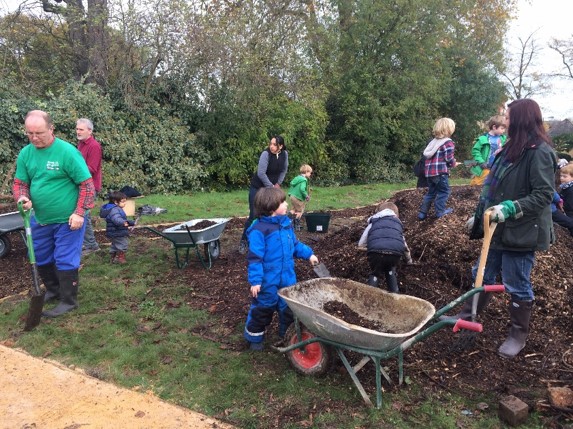 It also needed to have social spaces where the community could come together and share activities. In reality, initial aspirations have been exceeded and the play space is one of the best used in the borough. The community garden is equally well used and fears of anti-social behaviour haven’t materialised. Interesting features include a ‘nature walk’, an edible hedge and a wildflower meadow. The new works need to be maintained cost effectively and lifecycle costs were considered from the outset.
It also needed to have social spaces where the community could come together and share activities. In reality, initial aspirations have been exceeded and the play space is one of the best used in the borough. The community garden is equally well used and fears of anti-social behaviour haven’t materialised. Interesting features include a ‘nature walk’, an edible hedge and a wildflower meadow. The new works need to be maintained cost effectively and lifecycle costs were considered from the outset.
Along Hoe Stream in Woking, in slightly more rural surrounds than Lewisham, our designers are at work with the Borough Council and local community to see how major engineering works can also have habitat and health benefits. The area is prone to flooding and new works seek to mitigate this problem in ways that will have broader benefits for the community.
While a prime objective is to reduce flood risk, the proposed solution will also enhance water quality and provide ecological benefits. The stream corridor already has significant areas of valuable habitat and publicly accessible space, but early studies indicate that there are opportunities to increase this further. There is also the potential for Hoe Stream to become a more sustainable ‘transport’ corridor through improvements to the pedestrian and cycling networks. These will become accessible for wheelchairs and pushchairs, ensuring the whole community is able to benefit from the water environment throughout the year.
In addition to improving walking, cycling and nature-based experiences, a number of spaces along Hoe Stream will provide opportunities for local community events. These spaces will be sensitively designed to ensure they have no adverse effect on nature but will include picnic and seating areas, meadows and lawns, fitness trails and opportunities for natural play. The council hopes to provide the chance for people, young and old, to learn about their environment in an interactive way. Their aspirations, together with those of the local community, are high and the project provides an excellent example of how funding for an essential engineering solution can be fully utilised to achieve a wider range of health and habitat objectives.
Back in the heart of the city, in the Church Street area of Westminster, another exciting initiative is underway. The Green Spine project, located close to Church Street Market, is all about creating liveable streets and spaces. In simple terms, the brief is to see how ‘green’ the public realm of a densely populated urban area can be and, in doing so, pushing the boundaries of what can be achieved. Again, proposals have been developed in close collaboration with the very diverse local community. Schools, residents and businesses have all been involved and the prime objective has been to devise an approach that has a positive impact on the health and wellbeing of this multi-cultural community, as well as improving the ecology and urban habitat value of the area.
The context for Church Street is one replicated at many medium-to-high density urban locations across the country. It’s a largely residential area with a high proportion of social housing, local retail and schools, and a limited range of other amenities. Such developments were built when vehicles were ‘king’, with priority given to parking and access ahead of the needs of pedestrians and cyclists. Change is definitely possible in such locations and the challenge is to achieve something that is transformational, affordable and maintainable. As with all successful projects, the starting point has been to work with the community to explore their needs and see how, together, we can bring about change. With their assistance, costed design proposals have now been submitted for planning approval.
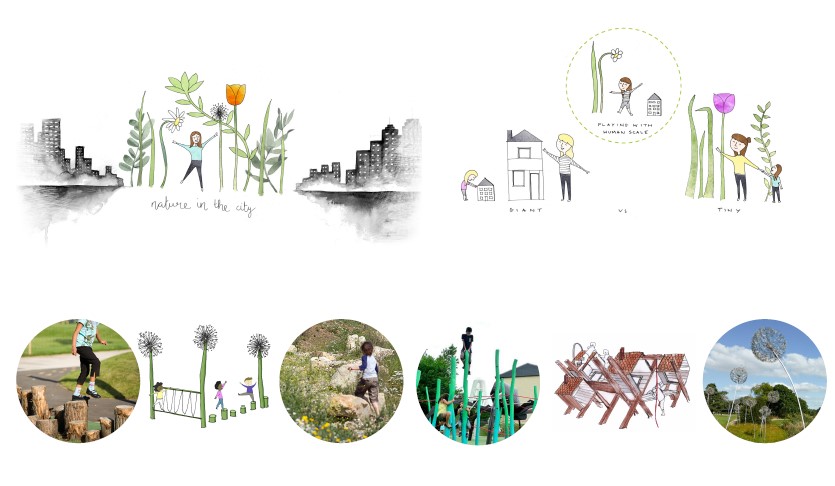 A well-considered ‘process’ is required to help achieve successful outcomes, so at the project’s outset, several key objectives were defined. These included the need to: improve accessibility for all age groups and abilities; create a flexible, community-focused outdoor space with the capacity to be used for a range of activities; improve movement around a pedestrian-focused space that also functions well for cyclists and vehicles; and enhance biodiversity, vegetation and introduce a sustainable urban drainage solution. Health and wellbeing are fundamental considerations of the overall project and, in defining an approach, elements that could have a positive impact on ‘mind, body and soul’ were all taken into consideration.
A well-considered ‘process’ is required to help achieve successful outcomes, so at the project’s outset, several key objectives were defined. These included the need to: improve accessibility for all age groups and abilities; create a flexible, community-focused outdoor space with the capacity to be used for a range of activities; improve movement around a pedestrian-focused space that also functions well for cyclists and vehicles; and enhance biodiversity, vegetation and introduce a sustainable urban drainage solution. Health and wellbeing are fundamental considerations of the overall project and, in defining an approach, elements that could have a positive impact on ‘mind, body and soul’ were all taken into consideration. 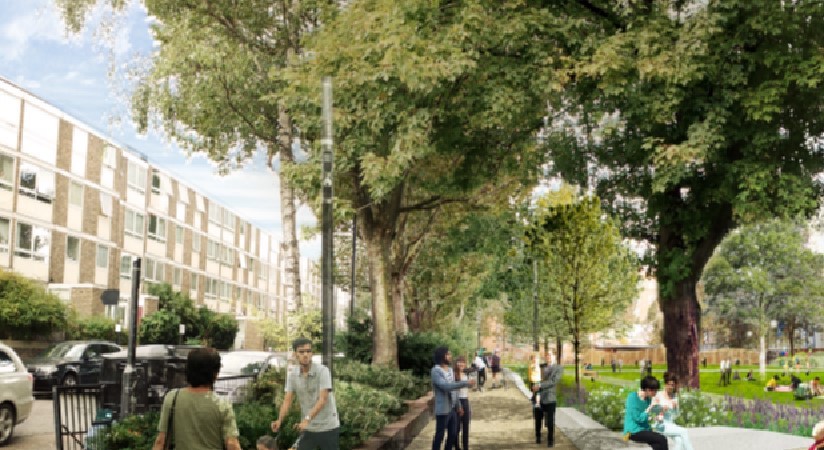
Having established the objectives, a vision was set. This, too, has multiple goals – most importantly, to create a place where people come first. The Green Spine presents the opportunity to provide green pedestrian routes where roads are narrowed to slow down vehicular movements and give pedestrians more space. There must also be places to sit and relax, with accessibility provided for everyone. Given the history of crime in the area, it must also become a safe and pleasant place to live. The new landscape must also be playful, with opportunities for learning and exploration. Finally, it must be sustainable, with trees, shrub planting and rain gardens organised in ways that set a precedent for the borough and the wider London area.
In contrast with Church Street, but within the same borough, are several projects in Mayfair and Belgravia. Here, demographic profiles are very different but there is a similar need to ensure businesses, visitors and residents have easy access to environments that encourage walking, cycling and a degree of respite away from the intensity of the West End. 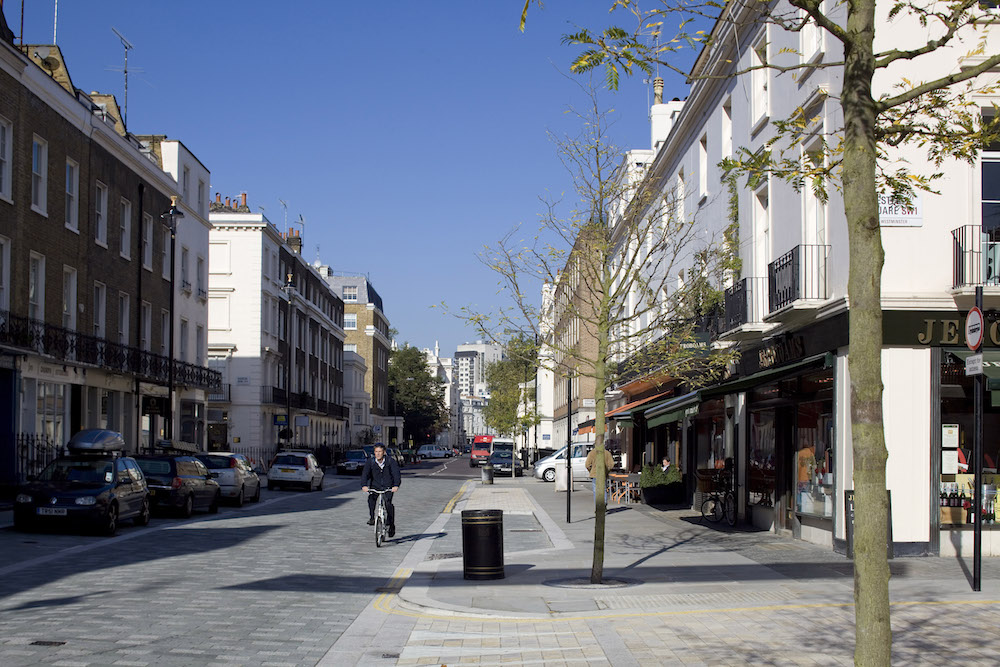
Over a period of ten years, progress has been made in gradually giving pedestrians priority over vehicles. While there has not been the desire to create ‘pedestrianised’ zones, there has been a consistent approach to narrowing carriageways and giving more space to pedestrians. This is resulting in a subtle but noticeable change, which has the outcome of making these areas feel more ‘walkable’. While the works are being undertaken on a street-by-street basis, they form part of an overall strategic masterplan, with each element contributing to the creation of a comprehensive solution that favours the pedestrian. Cyclists are also included in this approach, with bolder moves as part of a Transport for London city-wide strategy planned to accommodate key east-west routes. 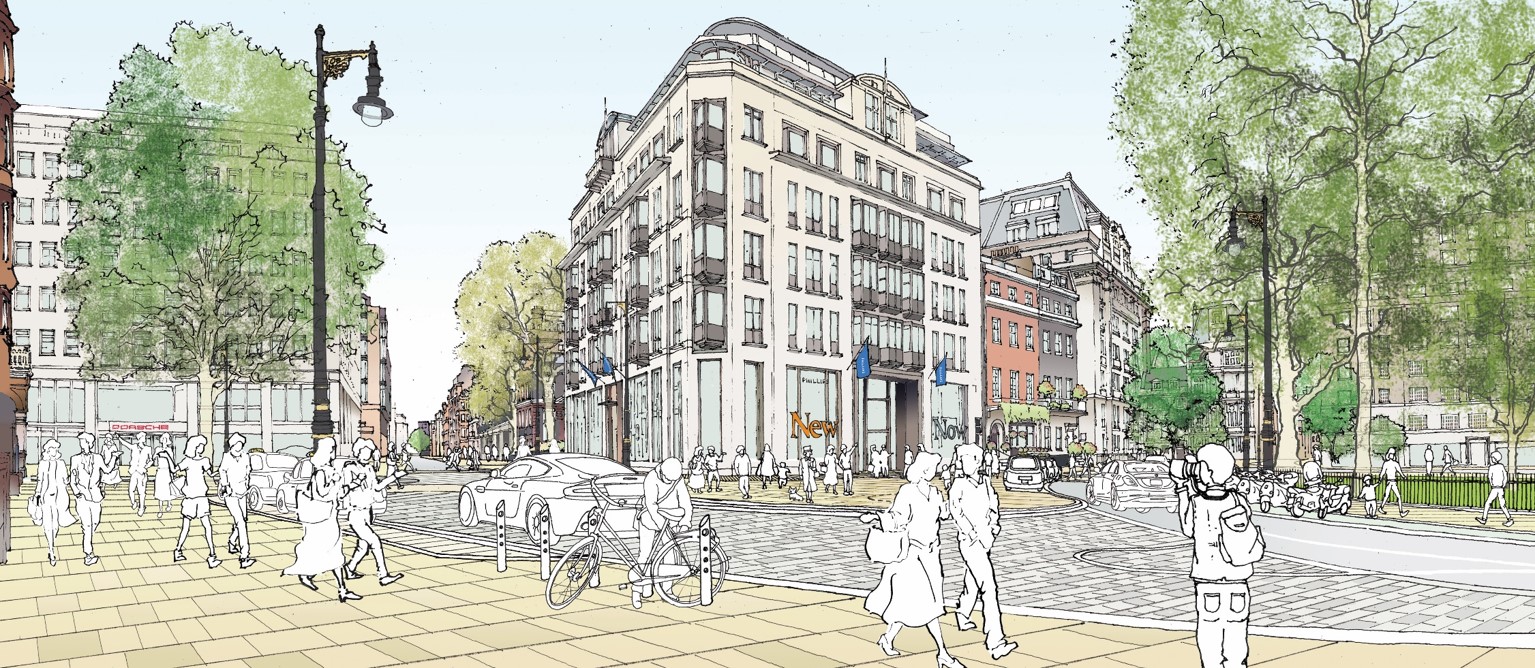
The already crowded streets of London’s West End will come under further pressure with the arrival of Crossrail, and measures are now being planned to create new networks of routes and spaces to encourage walking. A public realm with improved paving, tree planting, seating and street-focused cafés will help reinforce their appeal. Mayfair and Belgravia are also home to many successful businesses that are keen to promote their own wellbeing strategies. Improvements to the public realm will, in part, help them achieve this, encouraging employees to walk or cycle to work, or maybe head out for a productive ‘walking meeting’.
Conclusions
While there is anecdotal evidence that many of the initiatives underway are providing real benefit, more evidence-based feedback will help support the case for new projects. The QUERCUS study in Lewisham is helpful, with real data measuring positive changes in use of the green space and river corridor, although there is a general shortage of information linking money expended to benefit gained. Several organisations are now preparing such information, including the World Health Organisation (WHO), whose 2016 report ‘Urban green space interventions’ provides new benchmarks for approaches proven to be beneficial. This review provides public authorities with up-to-date evidence on the health impacts of urban green spaces and a systematic approach to quantifying and monitoring their use. Armed with information such as this, others are then able to develop projects that ensure urban green space delivers positive health, social and environmental benefits.
Achieving success is a complex but not impossible task, requiring the combined efforts of public health practitioners, urban planners, urban designers, architects, engineers, horticulturalists and landscape architects. There are already many success stories and we need to work with local communities and clients to understand their needs and, where necessary, be more persuasive, to ensure the design solutions we propose deliver maximum benefit.
Public Health England has a vision ‘where everyone, wherever they live, is able to live, work and play in a place that promotes health and wellbeing, supports active communities, and creates places to grow old in’. It’s a vision we must all support.
Author
Andrew Tindsley is a landscape architect and urbanism consultant. He was formerly a principal and director of landscape and urbanism at BDP.
Organisations involved

